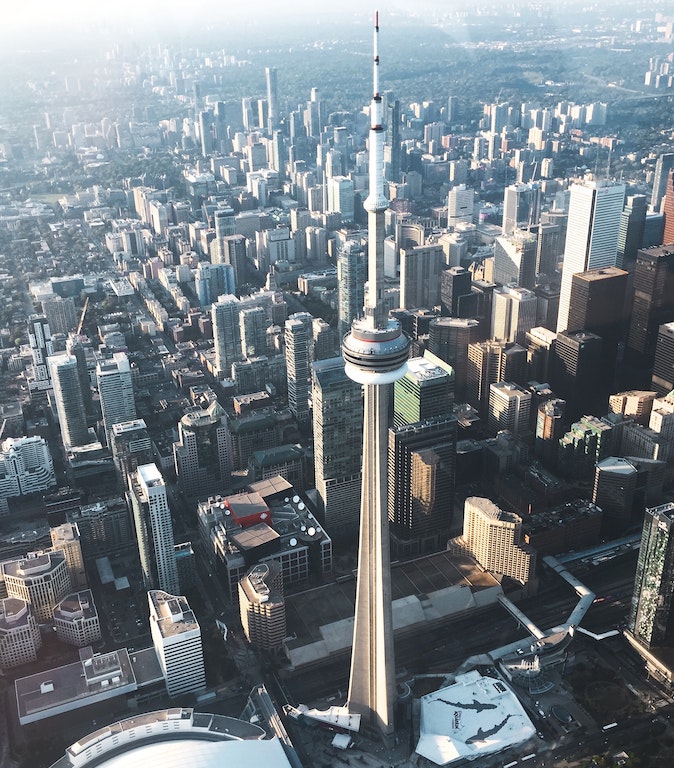
Toronto’s skyline is dominated by its signature structure, the CN Tower. At 1,750 feet high, it’s the tallest tower in the Western Hemisphere. Below are the office towers that have made the city the business center of Canada. Photo by Francesca Saraco, Unsplash
By Jacqueline Swartz
I’m looking down at Toronto from its most prominent symbol, the CN Tower. At the very top of the spire, 1,750 feet high, it’s the tallest tower in the Western Hemisphere. Through the wrap-around glass wall the sprawling metropolis is visible below. In one direction are skyscrapers, many of them built only in the last few decades. In another is the lakeshore, where boats dot the water and planes take off from a small airport on an island close to shore. Directly below is the Rogers Center, home to the Toronto Blue Jays and The Audience, a baseball sculpture that depicts fans as gargoyles.
Through the last few decades, this business and culture capital of Canada has acquired and shed more than a few identities to become what it is now – the Big Apple of Canada, an international city that lures visitors who come to see what the fuss is all about. But it didn’t happen overnight.
In the late 1970’s when the CN Tower was built, Toronto was experiencing a growth spurt in skyscrapers and in culture. The Toronto International Film Festival was starting to attract the kind of global audiences that would later make it one of the most important in the world. The Toronto International Festival of Authors was drawing A-list authors and crowds to match. Toronto’s previously underground theatre scene was starting to attract a wider audience, thanks to a winning combination of local talent and public funding. Larger theatres were built and became tryout venues for shows headed for Broadway. Toronto is now is ranked as the third largest theatre center after London and New York.
Toronto never had the charm of Montreal or the blithe confidence of New York, but things were changing. Bars were open later. There were more coffee houses and restaurants. The city once derided as “Muddy York,” and later dismissed as “Toronto the Good” for its 19th century Victorianism, was becoming prosperous and progressive.
But outside of Canada the city didn’t seem to have much of an identity. In Hollywood’s view, Toronto was an economical stand-in never destined for stardom. In 1997’s Good Will Hunting with Matt Damon, Toronto stood in for Boston. The 2002 musical Chicago with Rene Zellweger, had Toronto doubling as the Windy City. The deranged New York investment banker portrayed in the 2000 film American Psycho stalked the streets of Toronto, not Manhattan. In 2004’s teen comedy Mean Girls and the 2005 biopic Capote starring Phillip Seymour Hoffman, The city of Toronto appears in most of the scenes but gets credit only in agate type at the end of the credit roll.
The Toronto boom was not accompanied by the kind of civic self-esteem that would protect its Georgian and Victorian heritage buildings and its extensive shoreline on Lake Ontario. Instead, there was a seemingly unrestricted construction that, among other things, clogged part of the lakeshore with condos. Driving in from the west, on the Lakeshore Boulevard highway, you wouldn’t know a lake was there. This caused an outcry that protected other parts of the lakeshore.
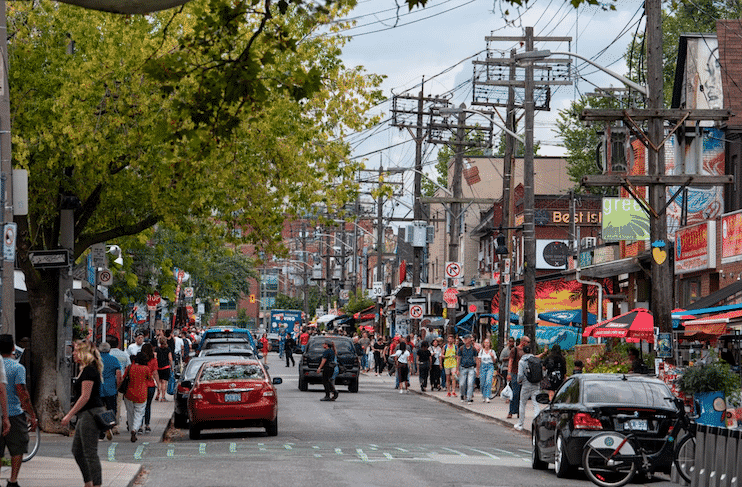
Kensington Market is a walkable neighborhood with a lot more than food markets. Places to eat, vintage clothing stores and street art draw locals and visitors. And not a condo to be seen.
One area that hasn’t succumbed to the wrecking ball is a cluster of streets in mid-town called Kensington Market. A market within a neighborhood, it’s a great place to spend an afternoon. Hole-in-the-wall shops sell everything from fruits and vegetables to cheese to vintage clothes, and it’s free of condos and chain stores. Kensington began as an enclave for Jewish immigrants from Eastern Europe, and some people still remember the live poultry for sale. Then it turned Portuguese, Jamaican, Latin American – and now hipster. Restaurants, many with patios, range from Turkish to tacos.
Start with a coffee at Moonbean, with its rickety wooden tables and chairs in a large front patio. Around the corner is Global Cheese, with a huge repertoire and helpful clerks. Across the street is Rasta Pasta, the brainchild of Mary Neglia and Magnus Patterson. They combined their culinary traditions to come up with dishes like Panini with Jerk Chicken and Reggae Lasagna with callaloo, a green leafy vegetable. Now that cannabis is legal in Canada, Kensington is a perfect place for a store called. Hot Box, whose sign reads, “Serving Potheads Since Ah….I forget”.
Many storefronts and alleys are painted with murals, and you never know what you’ll come across. A sign for Chinese Herbs with a canoe hanging in front. A sidewalk table with coconut gourds, ready to be opened. The sign above reads Moo Frites, a reminder that fries are a Toronto specialty, with wide-ranging versions of poutine, the Quebec classic of fries with cheese curds and gravy.
Across town is the other popular Toronto market, the St. Lawrence, dating from 1803. Serious food shoppers are drawn to the huge barn-like building with stalls selling produce, meat and fish. A glance at the posters and text on the walls show the history of the place originally called York. Across the street, farmers sell local fruit and vegetables.

The St. Lawrence Market draws local shoppers and visitors to its large 1807 building. There are food tours, and popular take-out eateries. Around it is one of Toronto’s first neighborhoods, with tall brick buildings and the St. James Cathedral. Adjacent are the Victorian gardens of St. James Park.
The St. Lawrence Market is a fine place for a grab and go lunch. On the main floor, try Buster’s Sea Cove for seafood – the lobster roll is outstanding. On the lower level the popular Uno Mustachio sells veal parmigiana and eggplant sandwiches with sautéed peppers, onions and mushrooms, enough for two. Churrasco is known for its eggy Portuguese tarts, a Toronto staple. There are picnic tables outside the market, but for a more romantic setting walk up the street to the Victorian formal gardens in St. James Park, next to St. James Cathedral, established in 1797.
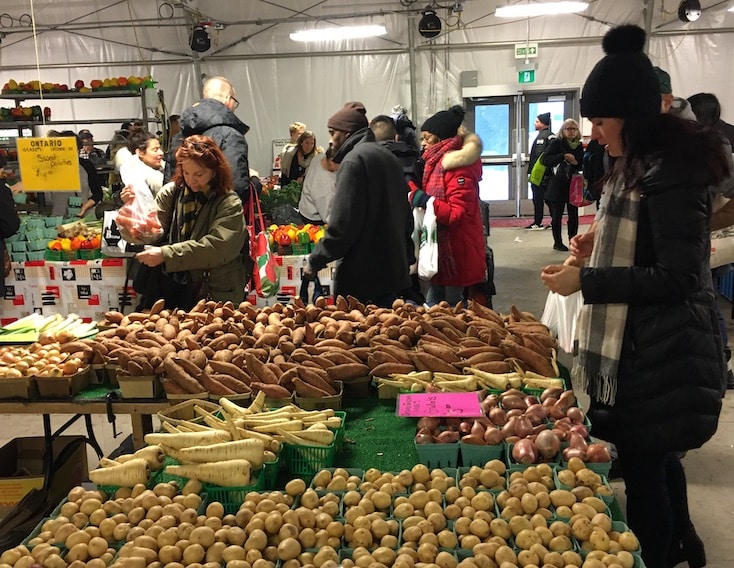
The Saturday Farmer’s Market is on the south side of the St. Lawrence Market. Local farmers get up before dawn and drive into Toronto to sell their fresh vegetables and fruit.
Nearby is the renowned Hockey Hall of Fame, a place of pilgrimage for hockey devotees. It’s housed in the renovated 1885 Bank of Montreal.
A 15- minute walk from the St. Lawrence Market is the Distillery District, the city’s Sleeping Beauty. It began in 1837, with the Gooderham and Worts Distillery occupying an area with Victorian industrial buildings and cobblestone streets. Falling into gradual disuse and decrepitude, it languished until the 1990’s, when a developer with aesthetic standards restored many of the buildings, banned chain stores and welcomed one of a kind boutiques and restaurants. Dine outdoors at El Catrin Distileria, an upscale Mexican Restaurant with artful murals on the wall. Or linger at the Cluny Bistro, with its achingly authentic French food and atmosphere. The Mill Street Brewery is a popular pub selling the Ontario brew.
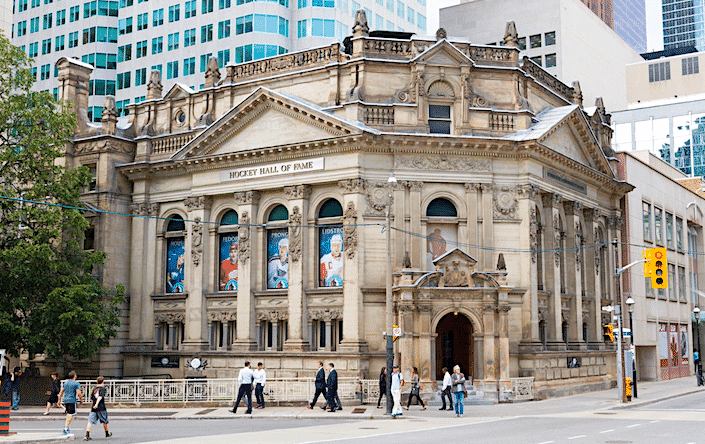
The Hockey Hall of Fame is famous for being the home of the Stanley Cup. In addition to memorabilia and the history of the game and its beloved Canadian players, it has a replica of a sports studio, where aspiring sports casters can audition in front of a camera.
This variety is typically Toronto. “You can have breakfast in a French bakery, lunch in a Pakistani restaurant, and have a Portuguese meal for dinner, says Jim Bamboulis, a travel writer, TV producer, photographer and videographer, who leads food tours in the Danforth, the Greek area of Toronto.
The Danforth, now branded Greektown, has always been one of Toronto’s most popular neighborhoods. Decades ago, when restaurants and bars were closing early, the Danforth was up late. It also had an unusual immigrant population. During the late 1960’s, educated Greeks fleeing the military coup d’etat in Greece, came to Toronto, where an older community had been established. They frequented coffee houses, where you could sit for hours over a cup of coffee (these places were not licensed to serve alcohol) and hear bands playing the best of contemporary Greek music. Even today, you might find accomplished live music, along with the scent of oregano and grilled fish, at restaurants like Christinas and Megas.
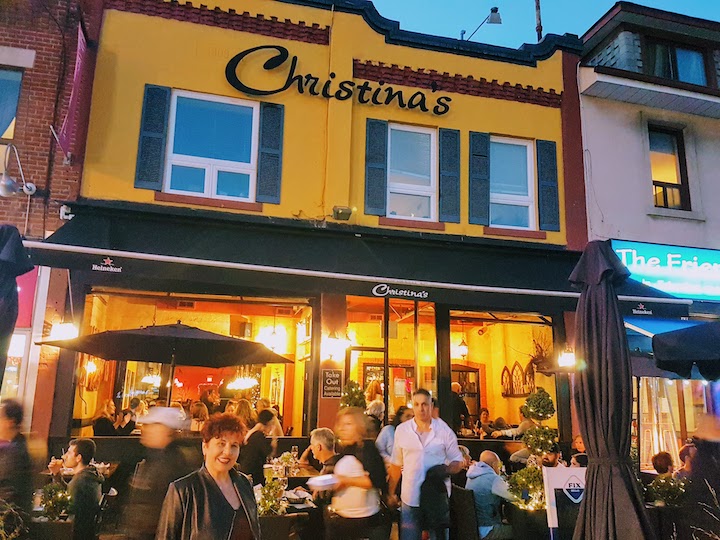
The Danforth, Toronto’s Greektown, is a popular spot for restaurants and shopping. Christina’s is one of the best known eateries, and serves Greek dishes, from stuffed peppers to grilled fish. One specialty is their eggplant salad. Go late at night and the place will be full. The area is served by several subway stops.
Jim Bamboulis has known the neighborhood since he was young. In 2016, when he turned forty, he ran the Athens Marathon. Something clicked. “I wanted to share the Greek experience through its food, the soul of the ‘hood”, he says. The result is what he calls Greek Food Care Packages. He sends his food parcels, which contain olive oil, feta cheese, olives and sweets, ranging in price from $25 – $65 to customers all over North America.
But one vibrant neighborhood does not add up to a city with charm and appeal. When foreign affairs writer and foreign correspondent, Olivia Ward was brought to Toronto in the l980’s by the Toronto Star, she was not impressed. “Growing up in the Canadian West Coast, with San Francisco as my mecca, I had no interest in this distant and boring money hub.” But after a dozen years working outside the country, “in hellholes and world capitals,” she returned to the city and revised her opinion. “I came to appreciate, then embrace it, because it had changed immensely for the better.”
Ward attributes some of the changes to the growing multicultural nature of the city, where half the population was born outside of Canada. And there is more: “I love discovering its many and varied neighborhood restaurants and cafes, and its lively classical music and theatre scene.”

Ripley’s Aquarium of Canada is a 135,000 square foot attraction with marine and freshwater habitats. Stand on the moving walkway as it winds through an underwater tunnel and see sharks and sea turtles swimming around you. Photo by Destination Toronto
In recent years, Toronto has come to appreciate what it has to offer. One example is a one- mile stretch named the Bloor Street Culture Corridor. It includes museums, concert venues and the Alliance Francaise, which offers free films on Thursday nights. Walking on Bloor Street, from east to west, there’s the Royal Ontario Museum and Koerner Concert Hall, which Meryl Streep has called her favorite place to hear music. Not far away is the delightfully quirky Bata Shoe Museum, a shrine to footwear through the ages, with special exhibits like shoes worn during the European Enlightenment. From moccasins to Manolos, the museum shows the historical importance of shoes.
Keep walking and you’ll reach the Bloor Street Cinema, popularly known as Hot Docs. The century-old theatre has been restored, and is one of the few in North America to screen mainly documentaries. It is also the site of the annual Hot Docs festival in June.
“There’s always a festival going on,” says lawyer and film producer Richard Watson, adding that viewers here take film seriously.
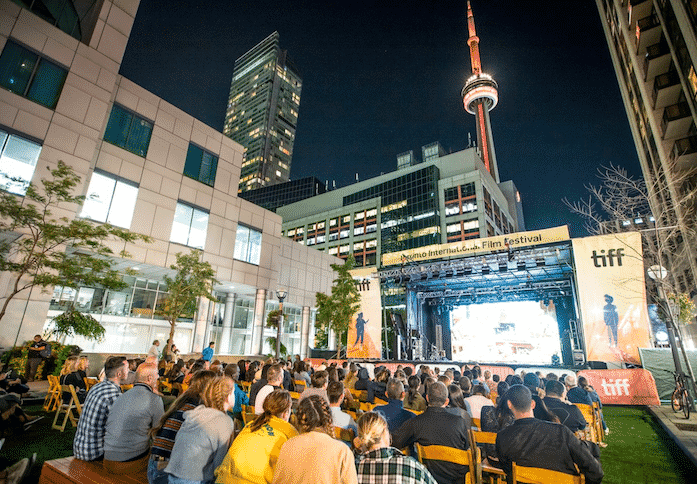
The Toronto International Film Festival is the city’s most popular annual event, drawing international stars, directors and producers every September. Most of the films are screened in the built-for-purpose TIFF Bell Lightbox theatre. But the street in front is closed off and there are outdoor concerts, too. Photo by Destination Toronto
A few blocks north is most upscale neighborhood of the city, Yorkville, a place that has changed dramatically over the last few decades. In the 1960’s it was a hippy enclave, drawing people to clubs like The Riverboat, where Joni Mitchell first performed Both Sides Now and Canadian rockers such as Neil Young and Gordon Lightfoot got their start. Today, the site is home to the upscale Hazelton Hotel. Its restaurant and terrace bar occupy a large outdoor area and is one of the places to be seen in Yorkville.
Strolling along Cumberland and Yorkville streets you’ll find boutiques by Chanel and Louboutin. There are pricey restaurants like the highly regarded Japanese Kasa Moto, but there also are reasonably priced eateries like Hemmingway’s and Trattoria Nervosa, which serves excellent thin crust pizza. But if you want to people watch go to the three-block long urban park on Cumberland, with its native grasses, wild-flowers and an oversized Canadian Shield boulder – a mini mountain. Authentic Canadiana in the midst of Euro Chic.
It’s enough to make a local want to staycate. Which is what Kathy Chant does frequently. The owner of the online cooking bookstore, Eat Your Words, she has availed herself of last-minute bargain prices for some of Toronto’s spiffiest hotels and eateries. One of her faves is the new Hotel X, which has “books everywhere, even in your room.”
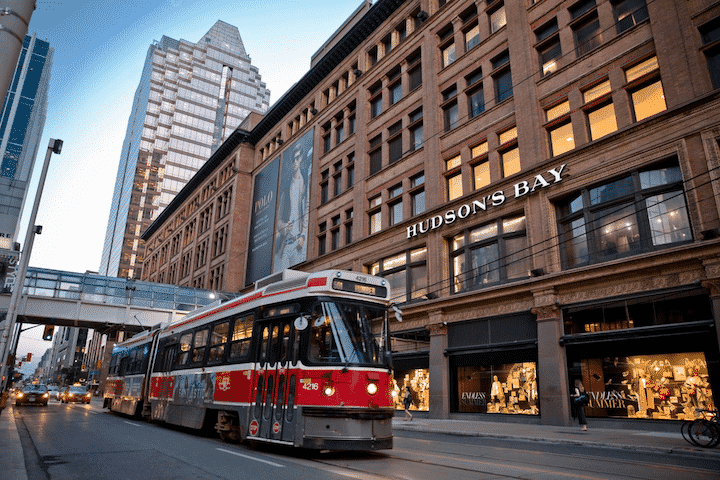
Two Toronto signatures are its streetcars and the Hudson’s Bay department store. Founded in 1670, Hudson’s Bay started with fur traders. A walkway connects the store with the Eaton Centre, Toronto’s multi-story urban mall.
Chant’s most recent discovery is the Fairmont Royal York, and its bar, called Clockwork. “I love its plush surroundings and fabulous cocktails. I go for their happy hour, and then head somewhere else for dinner”. At some trendy restaurants, she notes, Canadian chefs are using local products. “Indigenous cuisine is happening – venison, salmon with foraged vegetable and berries”.
From rolling up the sidewalks to rolling out the red carpet, Toronto has evolved from bland to bustling. Once a stand-in for other more glamorous locales, today’s Toronto is ready for its close-up.![]()
Planning a Visit? Then consider:
- The view from the top of the CN Tower is spectacular, but you’ll have to decide if it’s worth the cost of $39 Canadian dollars per person. Buying a ticket allows you to take photos through a glass window. There is a Sky Terrace at 1,122 ft. that allows an outdoor walk around the spire. But it is sheathed in dark wire mesh making photography impossible. There is a great view of the city from the CN Tower in the 360 Toronto restaurant, which takes 72 minutes to complete a full panoramic revolution.
- Toronto is served by a north-south/east-west subway system that is easy to navigate for visitors. Buses and street cars also will take you from east to west. Cyclists can rent bikes at numerous bike-share stands around the city. Uber and Lyft cars are readily available.
Jacqueline Swartz has written about travel, culture and health for major publications in Canada and the US.

